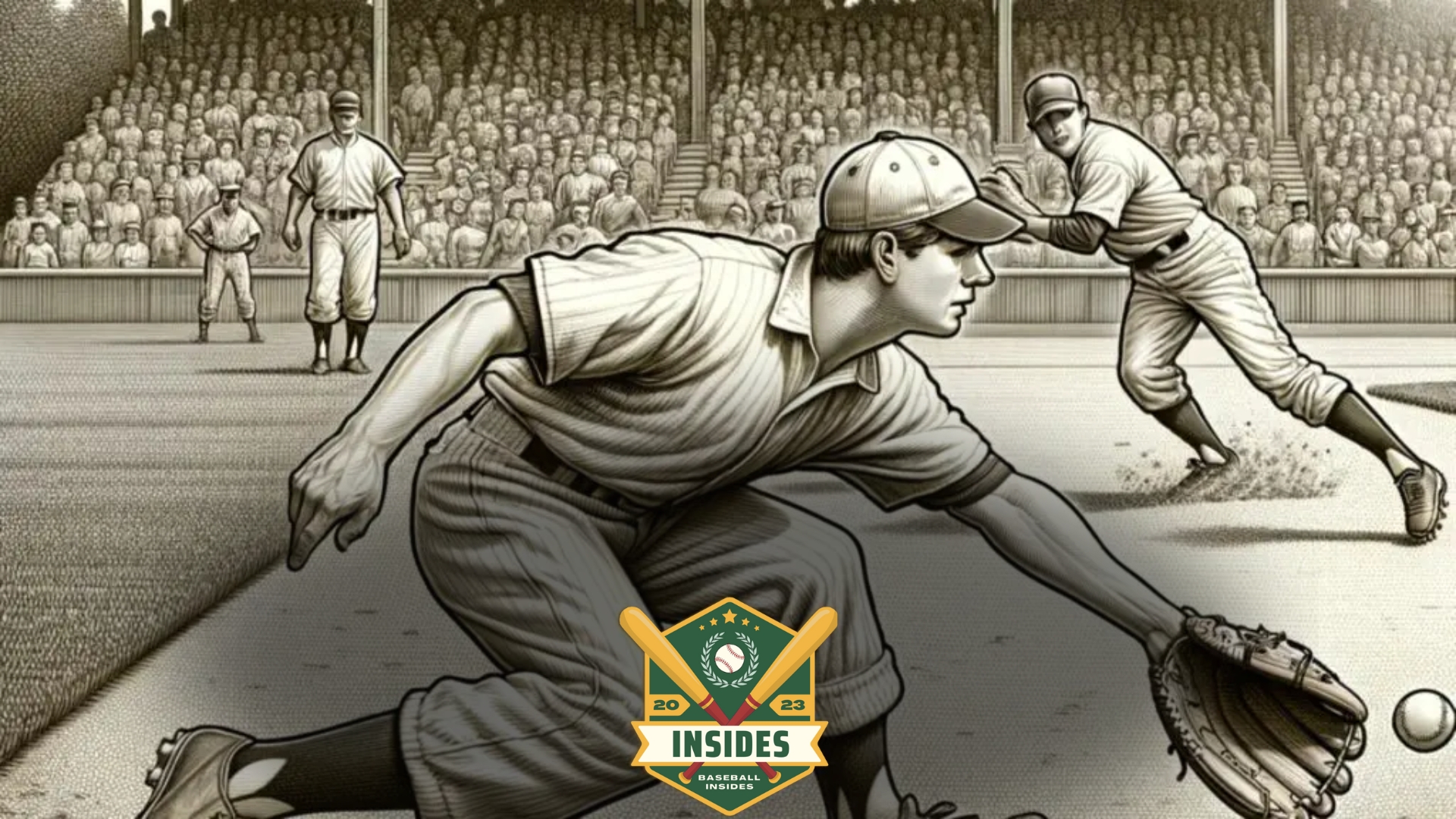
In this article:
Have you ever watched a baseball game and heard the commentators tossing around the term “assist” and wondered what they’re talking about?
You’re not alone. Often overshadowed by the more glamorous “home run” or “strike out”, the humble assist is an essential ingredient in the thrilling recipe of baseball. But what exactly is an assist in baseball?
An assist in baseball is credited to a defensive player who fields the ball and throws it to another player, aiding in the act of making an out. It’s a team play, a symbol of synergy in this highly strategic game.
The assist may not always make the highlight reel, but it’s a critical part of baseball’s intricate choreography. If baseball were a symphony, think of the assist as the subtle yet vital notes of a violin that support the booming dramatics of the cellos and basses (a.k.a., the home runs).
The Basics of Baseball Assists
Let’s dive right into the heart of the game: the art of the assist. In baseball, like a well-oiled machine, every player has unique roles contributing to the team’s success. Among these roles, one stands out for its critical importance in defense strategy: the assist.
An Assist, in a Nutshell
An assist in baseball occurs when a fielder plays a key role in getting an opposing player out. This could be by throwing the ball to a teammate who records the out or even deflecting a hit ball in a way that leads to an out.
It’s a testament to a player’s knack for team play and timing.
While discussing the intricacies of baseball, a fascinating aspect to explore is ‘What Does GIDP Mean In Baseball?’, which sheds light on how double plays can significantly impact a game’s dynamics.
Recording an Assist
Assists are officially recorded in the game’s statistics. For a player to be credited with an assist, they must have had a hand in the play immediately before an out is made.
It’s not enough to be part of the play; the player’s action must directly lead to an out.
Assists in different game scenarios
There are various game scenarios where assists can occur. They are essential to double and triple plays, where quick and accurate passing between fielders is crucial.
Fielders often make assists by throwing the ball to the player defending the base, who then tags the runner out.
The Unsung Heroes of the Field
While flashy home runs and strikeouts often steal the limelight, assists are the silent gears that keep the defensive machine running smoothly.
They may not always make the highlight reel, but any seasoned baseball fan knows their value. After all, a well-executed assist can be the difference between victory and defeat in a game of inches and seconds.
Different Types of Baseball Assists
Baseball, that great American pastime, is a game filled with nuance and complexity. One such nuance that might fly under the radar of the casual viewer is the ‘assist’. But what is an assist in baseball, and what are the different types? Let’s take a closer look.
Throwing Assists
When a player fields the ball and throws it to another player who creates an out, the player who threw the ball is credited with an assist.
This is the most common type of assist and can occur at any base. It’s a crucial part of double plays as well.
Deflection Assists
On the rare occasion, a batted ball might deflect off one player and be caught by another player who then makes an out. The player who initially deflected the ball receives an assist.
The beauty of baseball is that sometimes, the most unexpected plays can yield the most rewarding results.
Tagging Assists
‘Tagging assists’, as the name suggests, involves a player throwing the ball to another player who then tags out a runner.
This could happen during a rundown or when a runner attempts to steal a base. Teamwork does make the dream work!
Cut-off Assists
These assists are often seen when outfielders throw the ball to an infielder, who then relays it to another player to get an out.
The infielder who acts as the relay is credited with an assist. It’s like a well-choreographed ballet, with players moving seamlessly to complete the play.
Each of these assists showcases the strategic brilliance of this beloved sport. So next time you’re watching a game, keep an eye out for these assists.
They might not always make the highlight reel, but they’re a fundamental part of the game’s intricate beauty.
Understanding the basic rules of baseball, such as ‘How Many Players Are On The Field In Baseball?’, is essential for appreciating the strategic depth of the sport, including how assists contribute to the gameplay.
How to Record an Assist in Baseball
Capturing the essence of baseball isn’t all about home runs and strikeouts – it’s also about the subtler skills, like recording an assist.
Let’s delve into the mechanics of this crucial play.
What Constitutes an Assist?
An assist in baseball occurs when a defensive player contributes to the out of a baserunner.
This could be a shortstop who snags a ground ball and tosses it to the second baseman, who then tags the base for an out. In this scenario, the shortstop would be credited with an assist.
Recording an Assist
So, how do you officially record an assist in baseball? Well, it’s all about vigilance and accuracy with a dash of speed.
- Identify the play: The first step is to identify when an assist has occurred. This means spotting when a defensive player has directly contributed to a baserunner’s out.
- Record the player: Once you’ve identified the assist, record the identity of the player who made the play. This is typically noted by the player’s position number (e.g., 6 for a shortstop).
- Mark the assist: Finally, mark the assist in the scorebook. Assists are typically recorded as ‘A’ in the statistical column.
Key Takeaways
An assist is a vital part of the beautiful ballet that is baseball, often facilitating the all-important outs that swing the momentum of a game.
And though they might not always make the highlight reel, they’re an integral aspect of a well-rounded player’s skillset.
Famous Baseball Assists in History
You’ve probably witnessed many exciting plays if you’re a baseball enthusiast like me. Some of the most memorable moments in baseball history are the result of incredible assists.
Let’s walk down memory lane and revisit some of history’s most famous baseball assists.
Derek Jeter’s “Flip” – 2001 ALDS
One of the most iconic assists in baseball history came from the New York Yankees’ shortstop, Derek Jeter.
In the 2001 ALDS, with a swift, underhand flip, Jeter managed to throw out Oakland A’s Jeremy Giambi at home plate, a play that kept the Yankees in the running for the postseason.
Willie Mays’ “The Catch” – 1954 World Series
Although more known for the spectacular catch, Willie Mays’ assist in the 1954 World Series is equally impressive.
After making a miraculous over-the-shoulder catch, Mays threw the ball to the infield, preventing the runners from advancing.
Ichiro Suzuki’s “The Throw” – 2001 Regular Season
Ichiro Suzuki left fans and fellow players in awe during a 2001 game against the Oakland Athletics.
Suzuki caught a hit in right field and threw out a runner at third base from an astonishing distance, all on the fly. This incredible assist has been dubbed “The Throw”.
Assists might not get the fanfare of a home run or a strikeout, but as these plays show, they can be just as critical — and thrilling — in a game.
How to Improve Your Baseball Assists
As with any other skill in baseball, the key to improving your assists is practice. But, not just any practice – it should be targeted and specific.
Here are a few tips to help you boost your assist game.
Understand the Game
Before you can master assists, you need to understand how baseball works. Knowing where you should be at any given point and where your teammates are can improve your assists considerably.
This is because an assist isn’t just about throwing the ball; it’s about strategic positioning, too.
Improve Your Throw
A solid throw is the backbone of a good assist. It’s crucial to work on your throwing accuracy and power. Consider drills that focus on both, such as target practice or long-toss.
Work on Glove-to-Hand Transfers
Efficiency is key when it comes to assists. The faster you can get the ball from your glove to your throwing hand, the better. Practice this glove-to-hand transfer regularly to speed up your overall performance.
Practice Different Throws
Not all throws in baseball are straightforward. Sometimes, you’ll need to throw while running, leaping, or even mid-slide. Practice these different scenarios to be prepared for any situation that comes your way in a real game.
Boost Your Reaction Time
In baseball, every second counts. By improving your reaction time, you can get to the ball faster and make an assist before the runner reaches his destination. Try reaction drills to enhance this crucial skill.
Remember, being an assist master isn’t always easy, but with these tips and a lot of practice, you’ll surely improve!
Advanced Metrics for Evaluating Baseball Assists
So, you’ve got the basics of what an assist in baseball is. Now, let’s dive deeper and explore advanced metrics used to evaluate assists.
As with many things in baseball, there’s more to the story than just the raw numbers.
Range Factor (RF)
First up is the Range Factor (RF) measures a player’s defensive contribution regarding the total number of outs they’re involved in.
It’s calculated by adding the player’s assists and putouts, then dividing by the number of innings or games played. A higher RF generally indicates a more effective fielder.
Fielding Percentage (FP)
Next, we have Fielding Percentage (FP), which is simply the ratio of a player’s total plays (assists plus putouts) to their total chances (total plays plus errors).
A player with a high FP is consistent and reliable on the field.
Defensive Runs Saved (DRS)
One of the newer metrics is Defensive Runs Saved (DRS). This stat considers a variety of factors, like range and arm strength, and quantifies the number of runs a player saved or cost their team. A player with a positive DRS is considered above average defensively.
Ultimate Zone Rating (UZR)
Finally, there’s Ultimate Zone Rating (UZR), another advanced stat useful for evaluating fielders. UZR considers the number of runs a fielder saves or gives up based on their range, arm, and error rate. It gives a more complete picture of a player’s defensive skills.
Remember, though, that these stats are best used in tandem. They each reveal a different facet of a player’s defensive abilities, and together, they paint a richer, more nuanced picture of a player’s performance on the field.
The concept of an assist in baseball is further illuminated by decoding common infield plays, specifically answering ‘What Does 6 4 3 Mean In Baseball?’, which exemplifies teamwork and swift coordination among players.

FAQs
1. What is an Assist in Baseball?
An assist in baseball is credited to a fielder who helps to make an out. For example, if a shortstop throws a ball to a first baseman who tags a runner out, the shortstop gets credited with an assist.
2. How is an Assist Scored in Baseball?
Assists are scored any time a fielder handles the ball before an out is recorded, whether by a catch, a tag, or a force out. This includes throwing the ball to another player or simply handing it off.
3. Is There a Limit to How Many Assists a Player Can Have?
There’s no limit to how many assists a player can be awarded in a game or season. The more involved they are in making outs, the more assists they’ll likely have.
4. What’s the Difference Between an Assist and a Putout?
A putout is credited to the player who makes the final action that results in an out, while an assist goes to any player who touched the ball in the play leading up to the out.
5. Can a Pitcher Get an Assist?
Absolutely! If a pitcher fields a hit and throws it to a base for an out, they’re credited with an assist. Pitchers often have opportunities for assists since they’re right in the middle of the action.
6. Do Assists Count Towards Fielding Statistics?
Yes, assists are an important part of fielding statistics. They show how often a player is involved in plays and can give insights into their defensive capabilities.
7. Does an Error Negate an Assist?
If a fielder makes an error that allows a runner to advance, they won’t be credited with an assist on that play, even if they initially fielded the ball.
8. Can Multiple Players Get Assists on the Same Play?
Yes, multiple players can get assists on the same play. If a ball is hit and fielded by several players before an out is made, each of those players can be credited with an assist.
9. Can a Player Get an Assist and a Putout on the Same Play?
Yes, a player can be credited with both an assist and a putout if they first field the ball and then make the final action that results in an out.
10. What’s the Record for Most Assists in a Game?
The record for most assists in a single game by a player is 12, held by shortstop Tommy Corcoran, who achieved this feat in 1901.
Conclusion
In wrapping things up, it’s clear that the assist in baseball is a critical and intriguing aspect of the game. It’s more than just a statistic—it’s a testament to the teamwork and strategy that makes baseball a compelling sport.
Remember, assists aren’t just about making a direct play at a base. They can also involve strategic maneuvers like cutting off a throw or setting up a double play.
Each assist contributes to the team’s overall performance, shaping the game’s course in subtle but significant ways.
So, the next time you’re watching a baseball game, keep an eye out for those assists. They might not always make the highlight reel, but they’re every bit as essential to the beautiful game of baseball.






